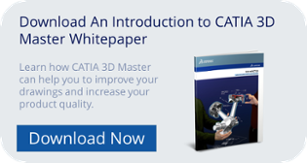 Traditionally, design methods have relied on 2D drawings as a key part of the product development process whilst serving as a reference for product definition.
Traditionally, design methods have relied on 2D drawings as a key part of the product development process whilst serving as a reference for product definition.
Despite 3D modelling’s large adoption, 2D still remained the reference for product definition. It’s something that has been debated and people have weighed up the pros and cons of both 2D and 3D, but nothing much has changed.
The problem is, 2D drawings alone can be insufficient and can lead to design errors as well as higher manufacturing costs. The CATIA 3D Master approach attempts to correct some of these issues by empowering all the functions within a company to find, share, annotate and actually improve products using the richer, and more modern format of information; 3D.There are a lot of companies that have moved away from 2D drawings and there are a lot of others that are in the process of changing. There are also companies continuing to use 2D drawings whilst leveraging 3D models as the master, a solution that does have its benefits!
But there are also a lot of companies that can’t quite make the move from 2D to 3D
The Business Challenges that come with 2D
There are certain business challenges that can be attributed to using 2D drawings. Some of which include tolerancing, annotation, parts lists and other critical elements of manufacturing such as quality control and the supply chain.
The problems lie in the fact that many 2D drawings are often required to describe a single 3D product.
When design or process changes are then made, the process can become difficult and error-prone, which requires correcting many drawings that are used together to describe the single 3D product.
There is also the issue that 2D design standards are not common as such around the world, and even pure 2D drawings are prone to misinterpretation if any of the annotations are missing.
2D has had its place in the design and manufacturing industry for many years, but as the technology and methods of doing something change, so to should the process, the process in this case being 2D drawings to describe a 3D product.
The Future is 3D
Maybe not in the case of the film industry (although they keep trying!), but for design and manufacturing, the future is 3D. Accuracy and quality are guaranteed by a single reference in 3D.
This reference can then be stored in one database for anyone, at anytime, in any place and avoids unsynchronized drawings and actually makes the process changes in production cheaper. Plus, drawing time is highly reduced!
Despite the gains and benefits of CATIA 3D Master, you have to consider your current business process and evaluate how effective it would be for you. For many, it would come as a huge advantage and speed things up as well as fix problems that might already be in your design process.
When using the CATIA 3D Master concept, consolidating the solid model of the part geometry, tolerance, annotations and parts list into a single dataset offers major advantages. For a start, the engineer can be certain that they are applying the tolerance to the desired feature and that anyone using this information can be sure that they are producing or measuring the correct feature. It effectively eliminates any confusion that might be had with different 2D drawing standards because 3D is universal and looks the same to everyone, regardless of where they are.
Another great thing about 3D Master is that there is a natural path from 2D master, so it is easy to implement and increases product and process quality. You can reuse 3D intelligence for downstream applications and there is a proven usage of 3D for contracts.
The future is 3D and the time is now. There are so many added benefits from moving over to 3D Master, such as; lower costs, less design errors, ease of re-using the complete product definition which includes tolerance, annotations and parts lists. Advanced users can even create templates containing tolerancing and annotations and parts lists that make it possible to automate new areas of the product development process.
Learn more about the CATIA 3D Master Concept here.
.png?width=139&height=70&name=DTE-Logo%20(4).png)

